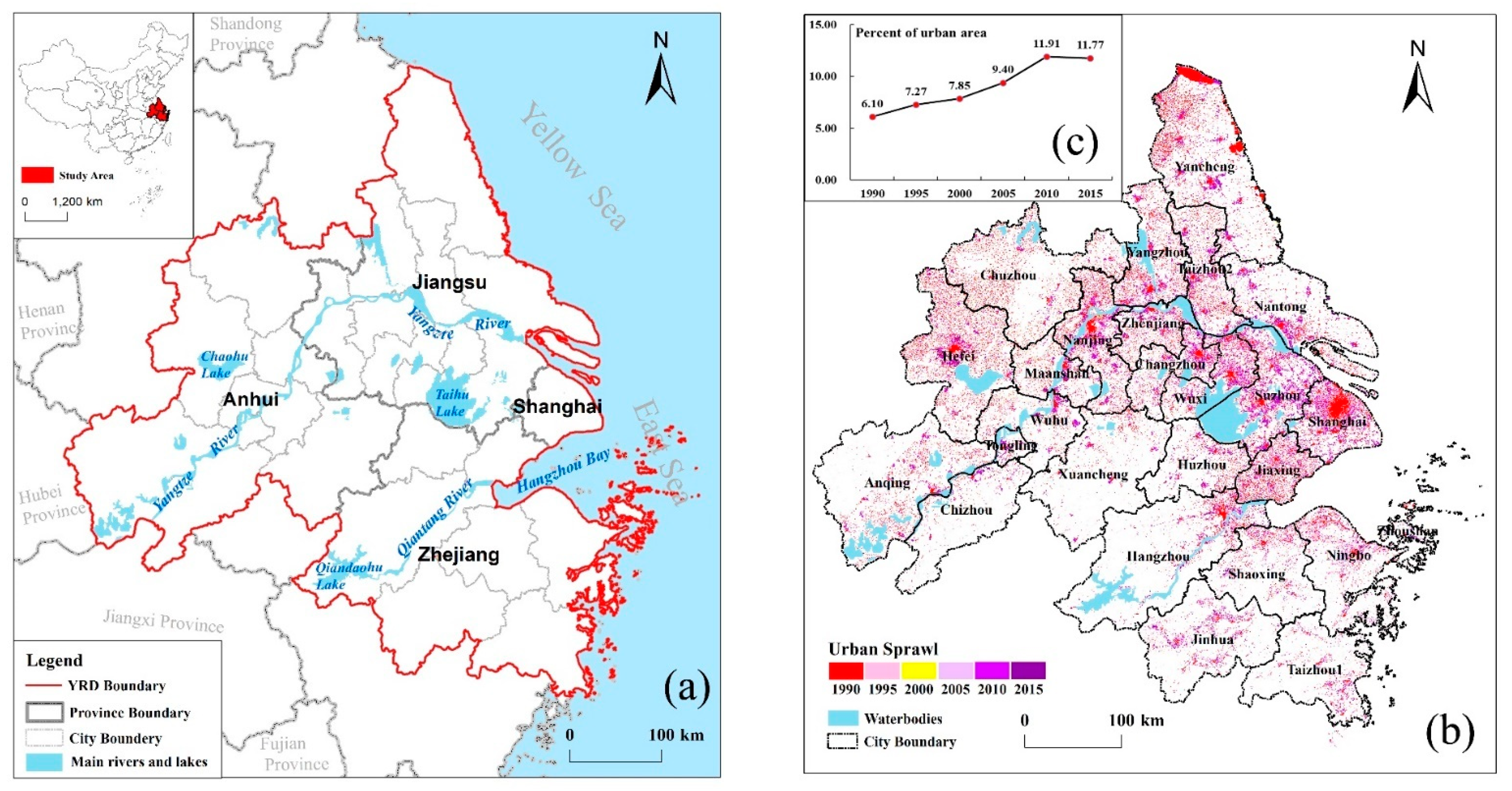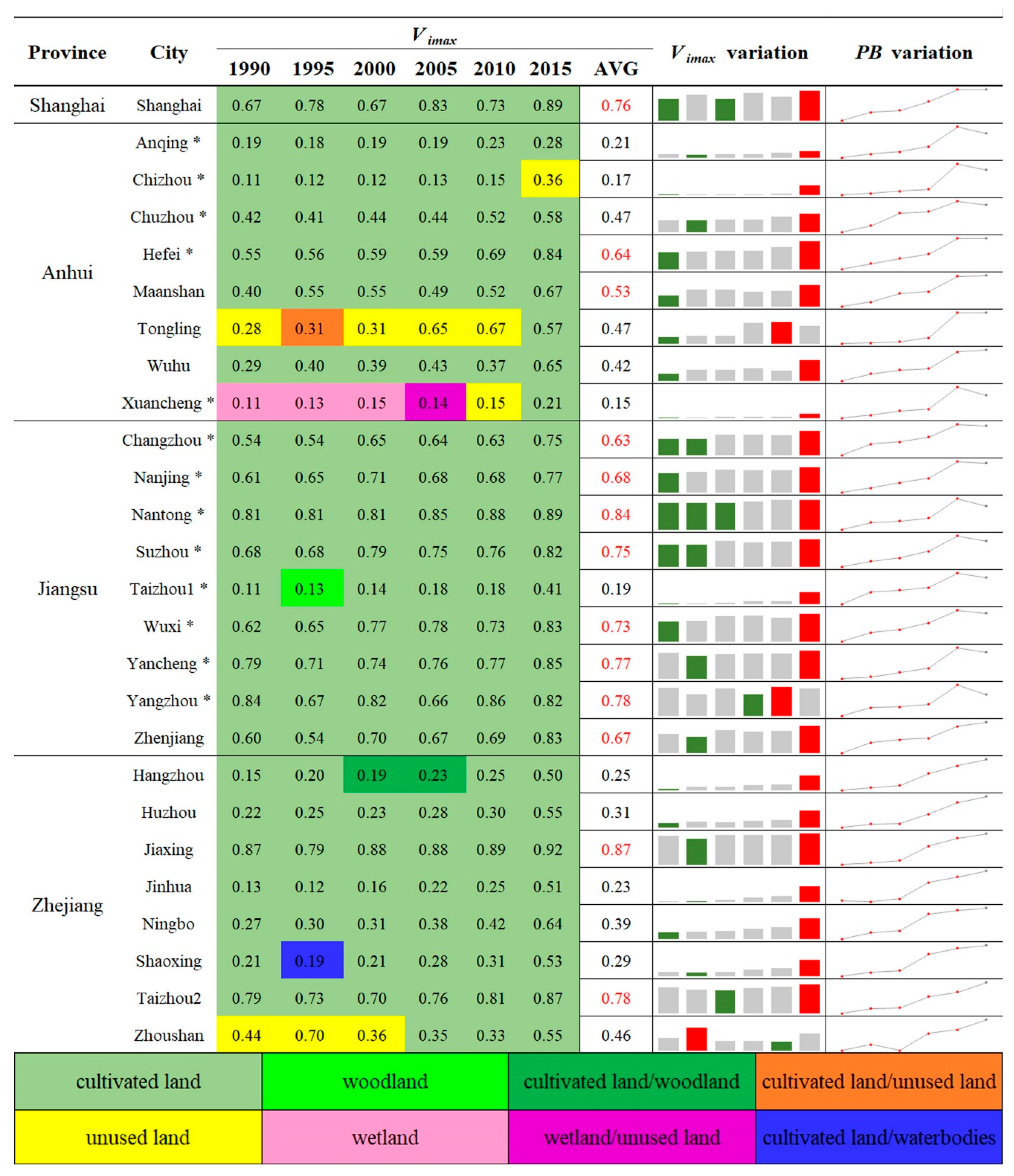Quantitatively Assessing Ecological Stress of Urbanization on Natural Ecosystems by Using a Landscape-Adjacency Index
Abstract
:1. Introduction
2. Methods
2.1. Study Area
2.2. Methods
2.2.1. The Landscape Spatial Adjacency (LAdI) Formulation
2.2.2. Urban Spatial-Expansion Index
2.3. Data and Processing
3. Results
3.1. The Dynamics of the LAdI at the 5 km-Grid Scale
3.2. The Dynamics of the LAdI at the Municipal Scale
3.3. Comparison between the LAdI and the Urban-Expansion Index
4. Discussion
4.1. The Implications of the LAdI
4.2. Comparison between the Edge-Based Index (LAdI) and the Area-Based Index (PB)
4.3. Future Works and Applications of the LAdI
5. Conclusions
Supplementary Materials
Author Contributions
Funding
Institutional Review Board Statement
Informed Consent Statement
Data Availability Statement
Acknowledgments
Conflicts of Interest
References
- Grimm, N.B.; Faeth, S.H.; Golubiewski, N.E.; Redman, C.L.; Wu, J.; Bai, X.; Briggs, J.M. Global change and the ecology of cities. Science 2008, 319, 756–760. [Google Scholar] [CrossRef] [PubMed] [Green Version]
- Seto, K.C.; Fragkias, M.; Güneralp, B.; Reilly, M.K. A meta-analysis of global urban land expansion. PLoS ONE 2011, 6, e23777. [Google Scholar] [CrossRef]
- Wang, L.; Jia, Y.; Li, X.; Gong, P. Analysing the driving forces and environmental effects of urban expansion by mapping the speed and acceleration of built-up areas in china between 1978 and 2017. Remote Sens. 2020, 12, 3929. [Google Scholar] [CrossRef]
- David, P.; Annemarie, S. A critical look at representations of urban areas in global maps. GeoJournal 2007, 69, 55–80. [Google Scholar]
- Liu, Z.; He, C.; Zhou, Y.; Wu, J. How much of the world’s land has been urbanized, really? A hierarchical framework for avoiding confusion. Landsc. Ecol. 2014, 29, 763–771. [Google Scholar] [CrossRef]
- Hahs, A.K.; McDonnell, M.J.; McCarthy, M.A.; Vesk, P.A.; Corlett, R.T.; Norton, B.A.; Clemants, S.E.; Duncan, R.P.; Thompson, K.; Schwartz, M.W. A global synthesis of plant extinction rates in urban areas. Ecol. Lett. 2009, 12, 1165–1173. [Google Scholar] [CrossRef]
- McDonald, R.I.; Mansur, A.V.; Ascensão, F.; Colbert, M.; Crossman, K.; Elmqvist, T.; Gonzalez, A.; Güneralp, B.; Haase, D.; Hamann, M.; et al. Research gaps in knowledge of the impact of urban growth on biodiversity. Nat. Sustain. 2019, 3, 16–24. [Google Scholar] [CrossRef]
- Pereira, H.M.; Leadley, P.W.; Proença, V.; Alkemade, R.; Scharlemann, J.P.W.; Fernandez-Manjarrés, J.F.; Araújo, M.B.; Balvanera, P.; Biggs, R.; Cheung, W.W.L.; et al. Scenarios for global biodiversity in the 21st century. Science 2010, 330, 1496–1501. [Google Scholar] [CrossRef] [PubMed] [Green Version]
- Alberti, M. The effects of urban patterns on ecosystem function. Int. Reg. Sci. Rev. 2005, 28, 168–192. [Google Scholar] [CrossRef]
- Liang, Y.; Liu, L. Simulating land-use change and its effect on biodiversity conservation in a watershed in northwest China. Ecosyst. Health Sustain. 2017, 3, 1335933. [Google Scholar] [CrossRef] [Green Version]
- Alberti, M.; Marzluff, J.M. Ecological resilience in urban ecosystems: Linking urban patterns to human and ecological functions. Urban Ecosyst. 2004, 7, 241–265. [Google Scholar] [CrossRef]
- Elmqvist, T.; Fragkias, M.; Goodness, J.; Güneralp, B.; Marcotullio, P.J.; McDonald, R.I.; Parnell, S.; Schewenius, M.; Sendstad, M.; Seto, K.C.; et al. Urbanization, Biodiversity And Ecosystem Services: Challenges And Opportunities. Available online: http://tailieuso.tlu.edu.vn/handle/DHTL/5103 (accessed on 21 May 2019).
- Noori, N.; Kalin, L.; Sen, S.; Srivastava, P.; Lebleu, C. Identifying areas sensitive to land use/land cover change for downstream flooding in a coastal Alabama watershed. Reg. Environ. Chang. 2016, 16, 1833–1845. [Google Scholar] [CrossRef]
- Phelan, P.E.; Kaloush, K.; Miner, M.J.; Golden, J.S.; Phelan, B.; Silva, H.R.; Taylor, R.A. Urban heat island: Mechanisms, implications, and possible remedies. Annu. Rev. Environ. Resour. 2015, 40, 285–307. [Google Scholar] [CrossRef]
- Walz, U.; Syrbe, R.-U. Landscape indicators—Monitoring of biodiversity and ecosystem services at landscape level. Ecol. Indic. 2018, 94, 1–5. [Google Scholar] [CrossRef]
- Lin, T.; Ge, R.; Huang, J.; Zhao, Q.; Lin, J.; Huang, N.; Zhang, G.; Li, X.; Ye, H.; Yin, K. A quantitative method to assess the ecological indicator system’s effectiveness: A case study of the Ecological Province Construction Indicators of China. Ecol. Indic. 2016, 62, 95–100. [Google Scholar] [CrossRef]
- Peng, J.; Tian, L.; Liu, Y.; Zhao, M.; Hu, Y.; Wu, J. Ecosystem services response to urbanization in metropolitan areas: Thresholds identification. Sci. Total Environ. 2017, 607–608, 706–714. [Google Scholar] [CrossRef]
- Li, P.; Cao, H. Comprehensive assessment on the ecological stress of rapid land urbanization per proportion, intensity, and location. Ecosyst. Health Sustain. 2019, 5, 242–255. [Google Scholar] [CrossRef] [Green Version]
- Güneralp, B.; Perlstein, A.S.; Seto, K.C. Balancing urban growth and ecological conservation: A challenge for planning and governance in China. Ambio 2015, 44, 532–543. [Google Scholar] [CrossRef] [Green Version]
- Lu, D.; Xu, X.; Tian, H.; Moran, E.; Zhao, M.; Running, S. The effects of urbanization on net primary productivity in Southeastern China. Environ. Manag. 2010, 46, 404–410. [Google Scholar] [CrossRef]
- Peng, J.; Shen, H.; Wu, W.; Liu, Y.; Wang, Y. Net primary productivity (NPP) dynamics and associated urbanization driving forces in metropolitan areas: A case study in Beijing City, China. Landsc. Ecol. 2016, 31, 1077–1092. [Google Scholar] [CrossRef]
- Tan, J.; Li, A.; Lei, G.; Bian, J.; Zhang, Z. A novel and direct ecological risk assessment index for environmental degradation based on response curve approach and remotely sensed data. Ecol. Indic. 2019, 98, 783–793. [Google Scholar] [CrossRef]
- Liu, X.; Huang, Y.; Xu, X.; Li, X.; Li, X.; Ciais, P.; Lin, P.; Gong, K.; Ziegler, A.D.; Chen, A.; et al. High-spatiotemporal-resolution mapping of global urban change from 1985 to 2015. Nat. Sustain. 2020, 3, 564–570. [Google Scholar] [CrossRef]
- Zhang, Q.; Seto, K.C. Mapping urbanization dynamics at regional and global scales using multi-temporal DMSP/OLS nighttime light data. Remote Sens. Environ. 2011, 115, 2320–2329. [Google Scholar] [CrossRef]
- Biondini, M.; Kandus, P. Transition matrix analysis of land-cover change in the accreation area of the lower delta of the Parana River(Argentina) reveals two succession pathways. Wetlands 2006, 26, 981–991. [Google Scholar] [CrossRef]
- O’Neillr, R.V.; Krummel, J.R.; Gardner, R.H.; Sugihara, G.; Jackson, B.; DeAngelist, D.L.; Milne, B.T.; Turner, M.G.; Zygmunt, B.; Christensen, S.W.; et al. Indices of landscape pattern. Landsc. Ecol. 1988, 1, 153–162. [Google Scholar]
- Hodgson, J.A.; Moilanen, A.; Wintle, B.A.; Thomas, C.D. Habitat area, quality and connectivity: Striking the balance for efficient conservation. J. Appl. Ecol. 2010, 48, 148–152. [Google Scholar] [CrossRef]
- Seto, K.C.; Fleishman, E.; Fay, J.P.; Betrus, C.J. Linking spatial patterns of bird and butterfly species richness with Landsat TM derived NDVI. Int. J. Remote Sens. 2004, 25, 4309–4324. [Google Scholar] [CrossRef]
- Senzaki, M.; Barber, J.R.; Phillips, J.N.; Carter, N.H.; Cooper, C.B.; Ditmer, M.A.; Fristrup, K.M.; McClure, C.J.W.; Mennitt, D.J.; Tyrrell, L.P.; et al. Sensory pollutants alter bird phenology and fitness across a continent. Nat. Cell Biol. 2020, 587, 605–609. [Google Scholar] [CrossRef] [PubMed]
- Hersperger, A.M. Spatial adjacencies and interactions: Neighborhood mosaics for landscape ecological planning. Landsc. Urban Plan. 2006, 77, 227–239. [Google Scholar] [CrossRef]
- Di Felice, P.; Clementini, E.; Hinterberger, H.; Domingo-Ferrer, J.; Kashyap, V.; Khatri, V.; Snodgrass, R.T.; Terenziani, P.; Koubarakis, M.; Zhang, Y.; et al. Topological relationships. In Encyclopedia of Database Systems; Metzler, J.B., Ed.; Springer: Cambridge, UK, 2009. [Google Scholar]
- Grekousis, G. Think Spatially; Cambridge University Press (CUP): Cambridge, UK, 2020; pp. 1–58. Available online: https://doi.org/10.1017/9781108614528.002 (accessed on 23 May 2020).
- Costanza, R.; D’Arge, R.; De Groot, R.; Farber, S.; Grasso, M.; Hannon, B.; Limburg, K.; Naeem, S.; ONeill, R.V.; Paruelo, J.; et al. The value of the world’s ecosystem services and natural capital. Nature 1997, 387, 253–260. [Google Scholar] [CrossRef]
- Jiao, L. Urban land density function: A new method to characterize urban expansion. Landsc. Urban Plan. 2015, 139, 26–39. [Google Scholar] [CrossRef]
- Lin, M.; Lin, T.; Sun, C.; Jones, L.; Sui, J.; Zhao, Y.; Liu, J.; Xing, L.; Ye, H.; Zhang, G.; et al. Using the Eco-Erosion Index to assess regional ecological stress due to urbanization—A case study in the Yangtze River Delta urban agglomeration. Ecol. Indic. 2020, 111, 106028. [Google Scholar] [CrossRef]
- Wu, J.; Hobbs, R. Key issues and research priorities in landscape ecology: An idiosyncratic synthesis. Landsc. Ecol. 2002, 17, 355–365. [Google Scholar] [CrossRef]
- Jiao, Y.; Xiao, D. Spatial neighboring characteristics among patch types in oasis and its ecological security. Chin. J. Appl. Ecol. 2004, 15, 31–35. (In Chinese) [Google Scholar]
- Eigenbrod, F.; Beckmann, M.; Dunnett, S.; Graham, L.; Holland, R.A.; Meyfroidt, P.; Seppelt, R.; Song, X.; Spake, R.; Václavík, T.; et al. Identifying agricultural frontiers for modeling global cropland expansion. One Earth 2020, 3, 504–514. [Google Scholar] [CrossRef] [PubMed]
- Hou, X.; Feng, L.; Tang, J.; Song, X.; Liu, J.; Zhang, Y.; Wang, J.; Xu, Y.; Dai, Y.; Zheng, C.; et al. Anthropogenic transformation of Yangtze Plain freshwater lakes: Patterns, drivers and impacts. Remote Sens. Environ. 2020, 248, 111998. [Google Scholar] [CrossRef]








| Year | 1990 | 1995 | 2000 | 2005 | 2010 | 2015 | AVG | |
|---|---|---|---|---|---|---|---|---|
| Scale | ||||||||
| City | 0.78 ** | 0.77 ** | 0.84 ** | 0.81 ** | 0.86 ** | 0.82 ** | 0.81 | |
| 5 km-grid a | 0.56 ** | 0.58 ** | 0.60 ** | 0.62 ** | 0.65 ** | 0.67 ** | 0.62 | |
| 5 km-grid b | 0.50 ** | 0.53 ** | 0.56 ** | 0.59 ** | 0.61 ** | 0.64 ** | 0.57 | |
Publisher’s Note: MDPI stays neutral with regard to jurisdictional claims in published maps and institutional affiliations. |
© 2021 by the authors. Licensee MDPI, Basel, Switzerland. This article is an open access article distributed under the terms and conditions of the Creative Commons Attribution (CC BY) license (https://creativecommons.org/licenses/by/4.0/).
Share and Cite
Lin, M.; Lin, T.; Jones, L.; Liu, X.; Xing, L.; Sui, J.; Zhang, J.; Ye, H.; Liu, Y.; Zhang, G.; et al. Quantitatively Assessing Ecological Stress of Urbanization on Natural Ecosystems by Using a Landscape-Adjacency Index. Remote Sens. 2021, 13, 1352. https://doi.org/10.3390/rs13071352
Lin M, Lin T, Jones L, Liu X, Xing L, Sui J, Zhang J, Ye H, Liu Y, Zhang G, et al. Quantitatively Assessing Ecological Stress of Urbanization on Natural Ecosystems by Using a Landscape-Adjacency Index. Remote Sensing. 2021; 13(7):1352. https://doi.org/10.3390/rs13071352
Chicago/Turabian StyleLin, Meixia, Tao Lin, Laurence Jones, Xiaofang Liu, Li Xing, Jinling Sui, Junmao Zhang, Hong Ye, Yuqin Liu, Guoqin Zhang, and et al. 2021. "Quantitatively Assessing Ecological Stress of Urbanization on Natural Ecosystems by Using a Landscape-Adjacency Index" Remote Sensing 13, no. 7: 1352. https://doi.org/10.3390/rs13071352






